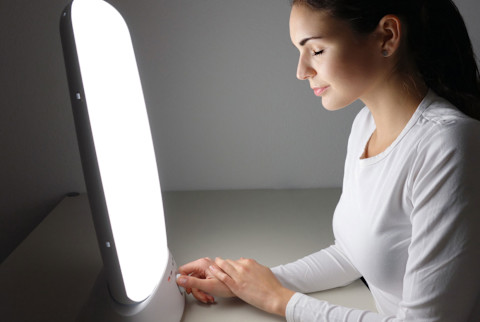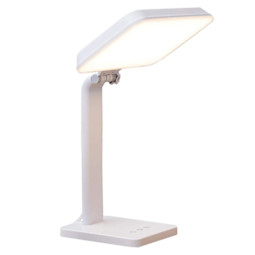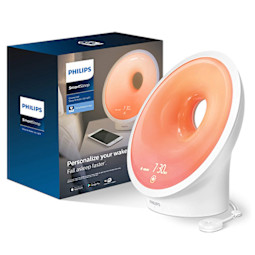
While the autumn and winter months bring cuddly weather and quiet, cozy nights at home, there's also a downside. Shorter days mean less sunlight, which causes some people to struggle with low mood or seasonal affective disorder (SAD).
Roughly 6% of the U.S. population is affected by SAD, while at least another 14% of adults in the U.S. deal with a lesser form of seasonal moodiness known as the winter blues. Research shows that light therapy via sun lamps is one key treatment that may help brighten their mood.
Here's what to know about sun lamps, how they work, and how to choose the best one for your needs.
A quick peek at the best sun lamps of 2023
How we picked
Brightness
All of the sun lamps featured emit a powerful light over 10,000 lux. This means they can have an impact within a relatively short sitting window, about 30 minutes.
Light color
White light is standard for a light box, but for those who want to mimic different sun phases like sunrise and sunset, you'll find some adjustable lamps with warmer hues too.
Price
The options on our list come in a variety of different price points—from $30 to $300—to fit different budgets.
Design
Featuring sleek designs that don't take up too much space, these lamps will fit seamlessly into your bedroom or home office setup.
Our picks of the best sun lamps of 2023:
Best splurge: Alaska Northern Lights Northstar 10,000 LUX Bright Light Therapy Lamp

Pros
- UV-free
- Suitable for multi-person use
- Durable
Cons
- Only one light color
- Expensive
Brightness:
10,000 luxLight color:
WhiteRecommended by diagnostic radiology specialist Ben E. Paxton, M.D., the NorthStar 10,000 delivers 10,000 lux of white light therapy to help combat the symptoms of seasonal affective disorder, depression during the winter months, and other mood disorders. The briefcase-size machine comes with a handle for easier maneuvering, but it's large enough to be used by multiple people at once. You can sit further from this light source than other, smaller models, and still reap the same benefits.
What reviewers say:
One customer who has had this light box for over 20 years insists that it still works as good as new to treat his Season Affective Disorder (SAD). "My wife and I both noticed a difference in my moods as well as my sleep patterns as a result of using these lights," he says.
Pros
- Features a task lighting setting
- Comes with a 5-year warranty
- UV-free
Cons
- Only one light color
- Larger than other models
Brightness:
10,000 luxLight color:
WhitePaxton appreciates that this Day-Light Sky lamp offers a maximum UV-filtered white light. The 10,000 lux model has been optimized to be flicker-free, so it can also help shed some light on your workspace and illuminate everyday tasks. It also comes in a task lighting mode, so you can easily switch back and forth between using it as a SAD lamp and a standard light fixture.
What reviewers say:
"I use the light on the high setting for about 15-30 minutes," one reviewer writes of how they use the multi-purpose light. "Sometimes I forget and get caught up reading something and go over the recommended time. This does not really seem to make much of a difference since I am using it so early in the morning. Many times I will switch over to the low setting after I have had it on high for 15-20 minutes. It is a really nice task light."
Pros
- UV-free
- Affordable
- Comes with 4 light settings
Cons
- Not as powerful as other models, so you'll need to sit closer to the light
Brightness:
10,000 luxLight color:
WhiteFor a more budget-friendly option, Paxton recommends the 10,000 lux TheraLite Aura. It has four light settings (including task lighting) that can effectively support a healthy circadian rhythm and comes in at a fraction of the price of more expensive models.
What reviewers say:
"What a mood-lifter! This light is powerful! It's great for Seasonal Affective Disorder and also as a work light at the sewing and craft table. It adjusts with a knob so you can aim the light across the room or down to your work surface," writes one reviewer.
Pros
- Compact
- Has white and yellow light
Cons
- Not as durable as other options
- Need to sit closer to the light if you're using it for therapeutic effects
Brightness:
10,000 luxLight color:
WhiteYellowWhile white light better mimics the sun's warmth, Paxton says that yellow light can also be soothing in lower doses. This affordable UV-free lamp touts both yellow and white light options, comes in four levels of brightness (you can adjust it from 25% to 100% brightness) and is packaged in a lightweight, portable case. It's a fair amount smaller than the other options on this list; reviewers note it's about the size of a Kindle.
What reviewers say:
"Love this product! (I'm) from Michigan where the winter is really harsh without the sun. I’ve been having this on at random times of the day every day and have noticed that I feel better in these gloomy days. Easy to dim and the two colors are very nice," writes one reviewer.
Pros
- Sleek design
- Bonus features like built-in meditations and alarms
Cons
- Not as effective as a SAD treatment; more of a wakeup light
Brightness:
10,000 luxLight color:
YellowRedThis Philips lamp came highly recommended by our experts, including Paxton. He says the alarm-meets-lightbox emits a warm glow that resembles that of a sunrise—plus comes with preprogrammed guided meditations. You can program the light to turn on at the time of your choosing (it transitions from soft red to bright yellow) and then emit a calming alarm noise, such as birdsong. Many sleep experts note that waking up with a gentle sunrise clock, sans a harsh phone alarm, is better for your sleep-wake cycle. Happy reviewers agree, noting that it helps them wake up feeling more energized.
What reviewers say:
"This wake-up light massively improved the quality of my sleep. It is so satisfyingly well-designed!" one reviewer writes.
Pros
- UV-free
- Affordable
- Comes in multiple color and brightness levels
Cons
- Some reviewers note it is not as durable as they'd like
Brightness:
10,000 luxLight color:
WhiteYellowThis Doraubia light comes recommended by Lizz Kinyua, M.D., a physician with a focus on mental health. A great entryway into light therapy, it has a sleek round design and emits light at 10,000 lux. It simulates three types of natural daylight—daylight, warm light, and natural light—to effectively help you to combat gloomy moods and rainy days. There is also little risk of eye damage as the lamp is UV-free. Plus, you'd never guess it's a light therapy box at first glance.
What reviewers say:
With over 6,000 Amazon reviews and an average rating of 4.6 stars, this model comes highly recommended—though the biggest complaint is that it isn't very durable for year-after-year use. "I really like both the look and functionality of this light! I bought it to use as light therapy for my seasonal depression, and I feel it has helped me gain those feel-good hormones I normally get from the sun. I really like that it has 3 colors of light and 4 levels of brightness and the remote," notes one reviewer.
Pros
- Unique design
- Easy to adjust light color and brightness
Cons
- Light needs to be placed close to face (~18 inches away)
Brightness:
10,000 luxLight color:
WhiteYellowThis wood-framed sun lamp is one of the best-looking on our list, but it's so much more than an attractive design. Like several others here, the DayBright Light Therapy Lamp provides the recommended 10,000 lux, full-spectrum, UV-free light. It also comes with a convenient remote control with presets and toggles so you can mimic the sunlight at different times of the day.
What reviewers say:
Reviewers appreciate that it's easy to adjust the color and brightness of this aesthetically pleasing light. "I do feel better when I use it," one reviewer writes. "I didn't think light can do that."
Pros
- Easily adjustable design
Cons
- Only one light color
Brightness:
10,000 luxLight color:
WhiteThis model from Circadian Optics provides the recommended 10,000 lux of brightness to help the winter blues, regulate sleep, improve focus, and boost energy. It'll last approximately 50,000 hours, which is longer than many fluorescent bulbs, according to the manufacturer. It also produces a uniform, dot-free stream of light that's comparable to the noonday sun.
What reviewers say:
"I bought two different lamps for my family for Christmas. This was my family's favorite one because it is the easiest to use. It is very portable and can be adjusted to shine down on you by bending it when placed on a higher surface, or directly at you when placed on a surface like a table," one reviewer writes of the adjustable lamp.
How sun lamps work.
Sun lamps are artificial lights that mimic the natural light we get from the sun. They are utilized in sunlight therapy or sun lamp therapy—a popular treatment among those suffering from seasonal affective disorder (SAD).
SAD is a type of mood disorder1, and its symptoms often include feeling sluggish or tired, having trouble sleeping, and experiencing difficulty concentrating during certain seasons. Most commonly these symptoms appear in the winter, but SAD can also occur in the summer months.
Bindiya Gandhi, M.D. tells mindbodygreen that sun lamps work by manipulating light to reset your circadian rhythm, which can be very helpful for those with SAD.
"Light therapy is not new, and doctors have long been recommending this therapy for many different ailments," Gandhi adds.
When used in the morning hours, sun lamps can also help ease morning blues, depression, lethargy, insomnia, and confusion2. According to Kinyua, these symptoms tend to occur during winter and autumn months because when it is dark for the majority of the day, our hormones can go a little haywire.
Sun lamps, Kinyua explains, "provide light just as bright as the sun to promote serotonin production3 and stop melatonin production4. When used continuously and in combination with other medications, they can be incredibly useful."
Finally, research shows that morning light5 can be helpful for those who have a slightly longer circadian clock and naturally want to wake up late and stay up late. Getting plenty of light in the morning—either by stepping outside or using a lamp—is a way to advance their internal clock and help them stick to a more regular sleep-wake schedule.
Benefits of sun lamps:
Improve sleep and energy levels.
Looking at a sun lamp when you wake up in the morning may increase your energy levels to start the day and help promote better sleep at night.
As Kinyua mentioned, the light suppresses the production of the hormone melatonin6, which signals to the body that it's time to be awake and alert. It can also regulate your body's internal clock throughout the entire day and into the night, making it easier to fall asleep.
Improve mood.
While more rigorous research is needed, some studies show7 that regularly using a sun lamp can improve overall mood—especially when combined with other mood-supporting activities.
Could help improve cognition in dementia patients.
Dementia patients often suffer from behavioral issues that stem from an altered sleep-wake cycle. Kinyua points to some early research8 that's found that "light therapy used in care homes has shown a reduction in agitation, night wandering, and low moods. These effects also last for a long while."
How to use sun lamps:
- Sun lamps work best for most people when they're used first thing in the morning after waking up.
- To get started, sit facing the lamp but not looking into its light source directly, as it can irritate the eyes.
- Position the lamp so it sits just slightly above your head and approximately 30 or so inches away from your face.
- Keeping the eyes open, sit in front of the light. The time you spend sitting in front of the lamp will vary based on the model you pick up and how bright it gets. (Each sun lamp is slightly different and may have different directions and durations of use.) However, an average of 20 to 30 minutes is usually more than enough for most people.
- You can do this every day until the season ends or until you no longer feel like you need it.
What to look for.
Before you go out and pick up a sun lamp, Gandhi recommends running it by your doctor—especially if you have a diagnosed mental health condition. They will be able to help you find one that is well suited to your needs.
With their go-ahead, here is what to look for during your shopping:
Lux brightness.
First, you'll want to look at how bright the light source can actually get. Joseph Kennedy, PharmD, a pharmacist with Consumer Health Report, explains that lightbox intensity is measured in lux. The lower the lux rating, the less powerful the light is and the longer you will have to use it to reap any benefits.
For example, a lightbox that emits 10,000 lux light takes around 30 minutes to elicit a response, while one that is 5,000 lux light takes about one hour to work, and if a lightbox emits 2,500 lux light, it will take around 2.5 hours to work.
Bulb type.
You'll want to make sure you're picking up a light that is specifically designed for this purpose. Things like tanning bulbs or halogen lamps will not be effective for light therapy.
"The light you use should have an ultraviolet filter to prevent your vision from being impacted by harmful UV rays," Kennedy says. "For this reason, it's even recommended to use a cool-white, fluorescent light. However full-spectrum fluorescent bulbs still demonstrate promising results."
The takeaway.
If you're one of the millions of people dealing with seasonal affective disorder, then light therapy could be worth looking into. Talk to your doctor to see what's the best course of action, and choose a sun lamp that best fits your needs. Don't forget to prioritize healthy sleep hygiene and a solid stress management routine to give your new source of light the best chance of brightening up your season.
Meet The Experts
8 Sources
- https://www.ncbi.nlm.nih.gov/pmc/articles/PMC4673349/
- https://www.ncbi.nlm.nih.gov/pmc/articles/PMC6746555/
- https://www.ncbi.nlm.nih.gov/pmc/articles/PMC3779905/
- https://pubmed.ncbi.nlm.nih.gov/30311830/
- https://www.ncbi.nlm.nih.gov/pmc/articles/PMC6751071/
- https://www.ncbi.nlm.nih.gov/labs/pmc/articles/PMC5299389/
- https://pubmed.ncbi.nlm.nih.gov/15800134/
- https://www.ncbi.nlm.nih.gov/labs/pmc/articles/PMC4822719/









